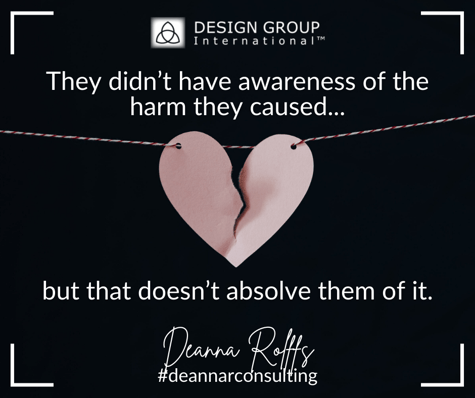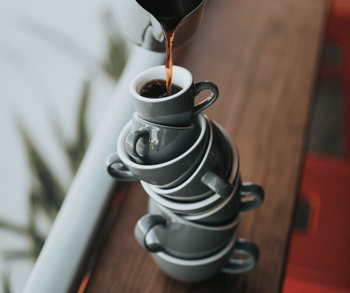When I was a young child, some adults played the “stop hitting yourself” game with me. They grabbed my hand, hit me with my own hand, and said over and over again “Stop hitting yourself. Why are you hitting yourself? Stop it.”
Yes, they thought it was hilarious. Me, not so much. It taught me that they thought my helplessness was funny, that I didn’t get to decide what happened to my own body. They didn’t have awareness of the harm they caused, but that doesn’t absolve them of it.

We white folks typically have a lack of awareness about white supremacy culture, blindly presume it’s right, true, and normal. Whiteness as a social construct, and white supremacy as a hierarchy based on race, are internalized as well.
Yawo Brown, in the Subtle Linguistics of Polite White Supremacy, shares that
“White America has been playing a centuries-long game of ‘stop hitting yourself’ while holding the arms of Black America. Polite White Supremacy has been feeding off the bodies of Black Americans while pretending Blacks cannibalize each other.”
I invite you to take a deep breath with me; I've learned that the truth is kind, albeit difficult at times. If this is your first time reading Leadrship & Learning Letters, please note that that this is the fifth of a Let's Talk About Whiteness series. I invite you to pre-read posts one, two, three, and four. Now, back to unpacking the violence of white supremacy.
A few illustrations of the violent hierarchy of whiteness in systems, organizations, and relationships are as follows:
 Passing legislation banning conversation about diversity, race or racism, bias, etc. by creating a moral panic related to (inaccurate definition of) Critical Race Theory, under the guise of protecting white children
Passing legislation banning conversation about diversity, race or racism, bias, etc. by creating a moral panic related to (inaccurate definition of) Critical Race Theory, under the guise of protecting white children- Protecting the feelings of white people over the lives of BIPOC people, particularly Black people
- Leaders naming or insinuating that Black people would be more successful if they acted more white
- Lack of priority placed on appropriately paying bilingual staff for their multi-language ability
- Lack of priority placed on translation for people that speak a first language other than English
- Prioritizing safety concerns for cis, binary gendered people over the accessibility of all-gender bathrooms
- Calling the police on a Black man watching birds in a park, because he asks a white woman to follow the law and put her dog on a leash
- Service and donation projects in the name of Christianity that preserves power and piety of the giver, without knowing or adjusting to what people with marginalized identities need or want
- Diminishing, minimizing, or gaslighting when an example of racism, sexism, LGBTQ+ oppression is shared
- Receiving calls for accountability and justice as personal, violent, attacks
- White dominant organizations naming diversity and inclusion as values without fully including (often without listening to and acting upon the advice of staff or clients with marginalized identities)
White people in North America live in a social environment that protects and insulates us from race-based stress. (DiAngelo, 2011). We expect comfort, and we react in very predictable ways when we are uncomfortable. We display white fragility, which is actually quite violent.
White Fragility is a state in which even a minimum amount of racial stress becomes intolerable, triggering a range of defensive moves. These moves include the outward display of emotions such as anger, fear & guilt, and behaviors such as argumentation, silence, and leaving the stress-inducing situation. These behaviors, in turn, function to reinstate white racial equilibrium. Robin DiAngelo (2011)
Fine (1997) identifies this insulation when she observes that “Whiteness accrues privilege and status; gets itself surrounded by protective pillows of resources and/or benefits of the doubt.” And that “Whiteness repels gossip and voyeurism and instead demands dignity” (p. 57).
 They assert that “Whites are rarely without these ‘protective pillows,’ and when they are, it is usually temporary and by choice. This insulated environment of racial privilege builds white expectations for racial comfort while at the same time lowering the ability to tolerate racial stress.” (Fine, 1997)
They assert that “Whites are rarely without these ‘protective pillows,’ and when they are, it is usually temporary and by choice. This insulated environment of racial privilege builds white expectations for racial comfort while at the same time lowering the ability to tolerate racial stress.” (Fine, 1997)
You may find the violence of white supremacy a newer concept; it's not new to People of Color, particularly Black people in North America. Anti-Blackness is the soil that nourished the roots of this country and is evident in its fruit.
"When You’re Accustomed to Privilege, Equality Feels Like Oppression."
How do you see the violence of white supremacy internalized in you, in your relationships, or in organizations or systems of education, healthcare, economics, etc.? Seeing it is key; then we work on liberation from it, together.
Fellow leaders and learners, I wish you courage and resilience for the journey.
Peace to you,

Read previous parts of the "Let's talk about whiteness" series here:
- Let's talk about whiteness - Part 1: Who are you, white person, to work for racial equity?
- Let's talk about whiteness - Part 2: You always talk about race; do you hate white people?
- Let's talk about whiteness - Part 3: What exactly is oppression?
- Let's talk about whiteness - Part 4: What is White Consciousness?

What I’m Reading & Watching
Regarding This Topic:
- The Subtle Linguistics of Polite White Supremacy by Yawo Brown
- CHAPTER 5: The Three Is of Oppression: Interpersonal, Institutional, and Internalized from The Psychology of Oppression by E. J. R. David and Annie Derthick
- The Folk Devil Made Me Do It by Code Switch on National Public Radio
- How to Deconstruct Racism, One Headline at a Time by Baratunde Thurston via Ted
- No White Saviors via Instagram

Questions for Consideration
Regarding This Topic:
- What topic would you like to hear more about here on Leadership and Learning Letters? What burning question comes up for you? Drop me a note at deannar@designgroupintl.com. Thanks!
- Do you see the violence that white supremacy perpetrates? How do you feel when the word violence is used?
- How is harm done by white fragility? Where do you see it occur? How do you interrupt it?

Other Leadership & Learning
Topics:

October 6, 2021




Comments